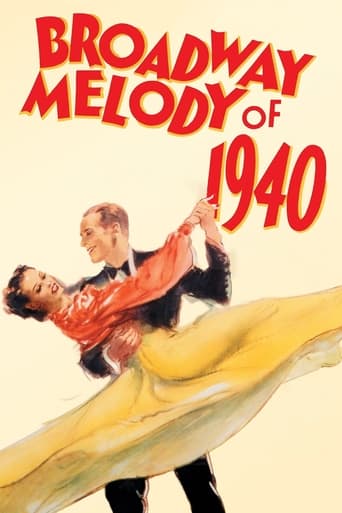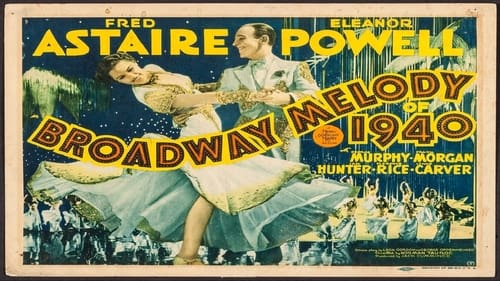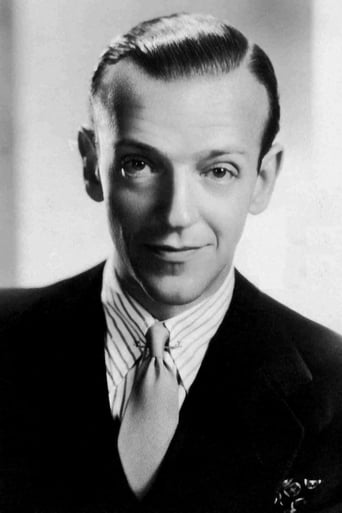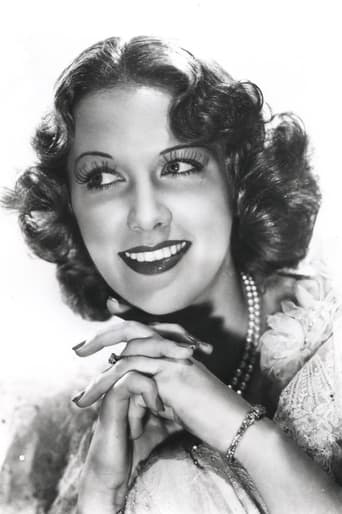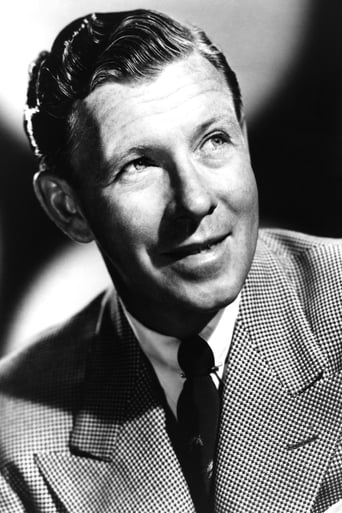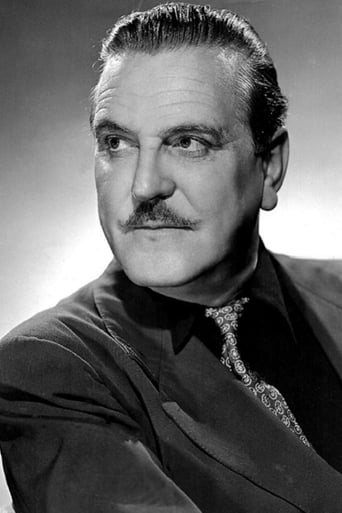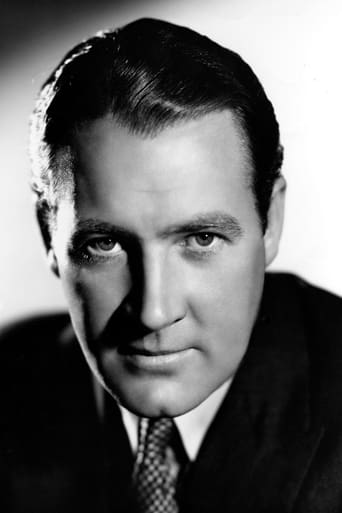vincentlynch-moonoi
This is the fourth and last film in MGM's "Broadway Melody" series, which began back in 1929. I've watched them all (for the first time) recently, and it's interesting to see how they evolved...and without question, this is the most sophisticated...although the two previous films were very entertaining.This is also the only time that Fred Astaire and Eleanor Powell ever appeared in film together. She the top female dancer, he the top male dancer, and they are great together.Here, a friendly...and then not so friendly competition between two friends, both dancers develops. Fred Astaire plays the somewhat more talented dancer, while George Murphy plays the slightly less talented dancer. In a mix-up involving the great Frank Morgan, Murphy gets selected to appear with Eleanor Powell in a big Broadway production over the more talented Astaire. The two partners (Astaire and Murphy) breakup, but can't quite separate. Meanwhile Murphy turns up drunk and unable to perform, and Powell finally realizes that her partner (in both dancing and love) was supposed to be Astaire.Astaire was great. Murphy was very good. What was the difference? Try watching each of them when tap dancing...look at just their feet. Murphy occasionally makes tiny missteps that are hardly noticeable. Astaire is always perfect.Supporting cast members include Ian Hunter as the producer.Two of Cole Porter's best compositions are found here. "I Concentrate on You" is an exceptional song, and is wonderfully sung here by Douglas McPhail and danced by Eleanor Powell and Fred Astaire. And perhaps the best song of all time -- "Begin the Beguine" -- is featured here, with Astaire and Powell dancing to 2 different interpretations in a wonderful routine (although I was not impressed with the vocal by mezzo-soprano Lois Hodnott.It's tough to criticize this film, although MGM made a big mistake here. They considered filming it in Technicolor, which probably would have resulted in it being one of the most remembered of the MGM musicals. But due to the war, they settled for black and white. A shame. For that reason alone, I'm giving it only a very strong "7".
weezeralfalfa
Wow, if this had only been shot in Technicolor! But, it's still great as is in crisp B&W. Perfect casting of the principals and supporting cast, with the occasional special talent also featured. Stage producer Frank Morgan contributed his trademark befuddled humor throughout. He was, of course, the wizard in "The Wizard of Oz" and, among other supporting roles, contributed humor to another 1940 top grossing film: "Boomtown". Poor future US senator George Murphy seemingly was always getting his girl stolen by some greater talent: Astaire in this film, Gene Kelly ,in "For Me and My Gal". and Sinatra, in "Step Lively". Nonetheless, he was a handsome charismatic vaudevillian talent, and a worthy dance partner for Astaire, early in this film, in one of the very few dance routines Astaire did in his film career with another male only dancer. Murphy was no stranger to Eleanor Powell, being her main dance partner in the BM of 1938 film, most notable for their 'dancing in the rain' number to ""I'm Feeling Like a Million". The present film is also special in that it provides the only dance pairing of Astaire and Eleanor. Eleanor was the only star featured in all of the BM series from '36 through '40. Although Astaire was given top billing, clearly Eleanor was the de facto top dancing talent, with or without a single partner. In addition to her 3 dance routines with Astaire and one with Murphy, Eleanor got one sole routine, where she is swung around by a large contingent of male dancers dressed as sailors, after doing her song and tap dance routine.Astaire also gets a solo dance, in which he expresses his infatuation with Eleanor's character, carrying around her photo. Rather reminds me of Kelly's later ballet "A Day in NYC", in which he used s picture of Vera-Ellen as one of his props, expressing his infatuation with her... Several specialty acts are included. Fred is intimidated by an impromptu juggling act by a woman(Trixie Firschke) in a waiting room outside the director's office. Carmen D'Antonio's Red Skelton-like burlesqued opera act was mildly entertaining, if the story director didn't think so, and I can understand if you don't either. Mostly,a diversion for the kids in the audience, I suspect. These acts took the place of Robert Wildhack's snoring and sneezing analyses in the BM '36 and '38 films respectively, which many present day viewers complain about.Murphy gets the role as Eleanor's dance partner by a mistaken identity fluke. The producer(Morgan) actually wanted Astaire, but Astaire switched their names, thinking Morgan was a bill collector.Anyway, Murphy eventually parties too much, is late for a rehearsal, and drunk for a show. Astaire, in disguise, subs for Murphy in the show at the last second, but tells Murphy he did the show before passing out. Actually, it's clear from the rotund head and face shape that it's not Astaire behind the mask and cap in the first non-dancing portion of this number. Presumably, it's baritone Douglas McPhail, who does the initial singing. Eleanor, backed by a ballet troupe, does a twirling ballet routine during this portion, before Astaire shows up behind the mask to dance with her...Later, Murphy shows up apparently drunk again, for the next show. Astaire again has to sub for him at the last second, this time without a mask. This is the famous very long "Begin the Beguine" number, which featured a very expensive stage set, involving a reflecting glass floor and a pitch black background with many 'stars', simulating a tropical night.The performance is divided into several segments. First, the lyrics are sung in a traditional languid style, backed by a dance troupe.Eleanor joins the troupe and gradually takes the spotlight, followed by Astaire, after which they dance together for quite a spell. The duo then disappear, while the Merry Maids sing a swing arrangement, again backed by a dance troupe. Eleanor and Astaire again dance, to an Artie Shaw-like version, followed by a segment with no music, then finish up with frantic dancing, again to background music. Murphy then surprisingly shows up, apparently sober, the dance duo graspe the significance of his drunk act, and the 3 stars dance a bit for the finale, leaving the audience in a feel good mood."Begin the Beguine" had been introduced on stage in '35, but it took several years for audiences to warm up to it's unusual musical structure, much helped by Artie Shaw's swing version. It was again featured in an elaborate dance number in the Porter biop "Night and Day", where the dancing style was quite different: with emphasis on sensuality rather than very rapid tandem dance steps. I thought the screen play was well thought out and well paced. The chemistry between Astaire and Eleanor was somewhat lacking. Except for a few scenes, the melodrama didn't get too nasty. All was forgiven in the end, when Astaire's and Murphy's characters showed they still had great respect for each other, despite their recent problems, instigated by the appearance of Eleanor. Actually, I thought the dance by Murphy and Eleanor was as elegant as any of the several Astaire-Eleanor pairings. Perhaps Astaire's major limitation as a dance partner was his inability to fully lift or carry most of his dance partners. He simply didn't have the strength, being quite skinny. Thus, we see Murphy lifting and carrying Eleanor several times during their dance, whereas I don't remember Astaire doing a full lift in any of his dances with Eleanor.
